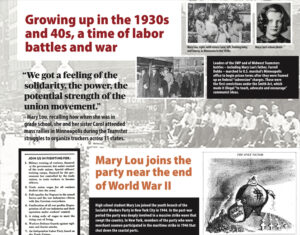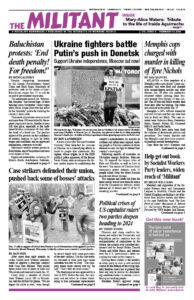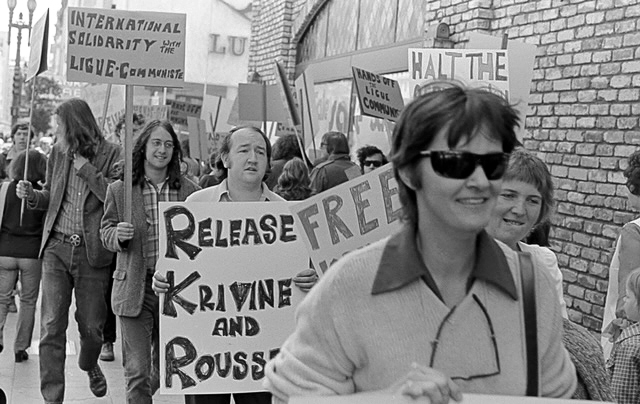OAKLAND, Calif. — More than 50 people gathered here Jan. 21 to celebrate the life and political contributions of Mary Lou Montauk, a member and supporter of the Socialist Workers Party for 78 years. She died Jan. 5.
“Mary Lou stayed the course,” SWP leader Betsey Stone told the gathering. “She was a cadre of the Socialist Workers Party, ready to do whatever was needed to strengthen the revolutionary party and the working class.”
Born in 1930 in Minnesota, Montauk grew up during a time of labor battles and approaching war. Her father, Farrell Dobbs, was the central organizer of the Teamsters’ 11-state over-the-road campaign in the Midwest and later served as national secretary of the Socialist Workers Party.
“We got a feeling of the solidarity, the power, the potential strength of the union movement” at large Teamster rallies, Montauk recalled about her childhood.
During a buffet reception organized by party supporters, participants studied a panel display depicting her life, and read 18 messages to the meeting, including from the Communist Leagues in Australia and Canada.
“Mary Lou had a serious approach to every party task, small or large, based on her understanding of the stakes in what the party is dedicated to — organizing the working class to take power out of the hands of the capitalists,” Stone said.

She joined the youth branch of the SWP in New York toward the end of World War II when she was 14. Her father was in prison, one of 18 leaders of the Socialist Workers Party and the Teamsters union framed up by the Roosevelt administration and the FBI under the Smith Act — a gag law making revolutionary ideas a crime. “Their real crime was winning workers to oppose U.S. war aims in World War II,” Stone said.
During the strike wave that swept the country after the war, party members who were merchant seamen in New York city, where Montauk was a member, were part of a maritime strike that shut down the docks on both coasts.
She moved to Chicago in the early 1950s, as Joseph McCarthy’s anti-communist witch hunt unfolded, but within a few years the Black-led movement for civil rights took off. SWP members were part of protests against the lynching of Chicago youth Emmett Till in Mississippi. They built labor support for the Montgomery Bus Boycott and the defense of Black families in Chicago who were attacked when they moved out of overcrowded segregated areas into all-white neighborhoods.
In 1960, Mary Lou moved to California with Paul Montauk, who became her husband and companion until his death in 1998.
Osborne Hart was a leader of the SWP branch in San Francisco in the 1990s. Montauk regularly staffed its bookstore, he said. “She welcomed workers who dropped in, explaining this is a place to learn about the working-class movement.”
A photo on the display showed Montauk marching to back the fight of strawberry farmworkers to organize and against deportations of workers without papers in Watsonville in 1996.
Way before the rise of the second wave of feminism in the late 1960s, Montauk was a champion of women’s rights. “As a working-class fighter and mother of four children, she understood the pressures coming down on working women, what it takes to care for children, hold down a job and be politically active,” Stone said.
“She drew on the writings of Frederick Engels, Lenin and Evelyn Reed to understand women’s oppression, its roots in the rise of private property and how it can only be ended by a socialist revolution. This continuity is the foundation of the working-class course the party is on today, joining union fights for sustainable hours, child care and other measures to lift from women the burden of child care and housework.”
A message from Helen Meyers from Minneapolis explained that in the late 1960s Montauk helped win Meyers and other young people to “building a movement of the broadest forces to oppose the war in Vietnam.” Montauk “taught us in word and deed you always upheld your principles and put forward the party’s program regardless of the pressure you faced.” She helped build a contingent of 500 active-duty GIs in a 1968 San Francisco protest.
Solid confidence in the working class
“How did Mary Lou Montauk stay the course for 75 years?” SWP leader Norton Sandler asked.
“First, you can’t do it without conquering the communist program. Mary Lou was never light-minded about theory, the history of the SWP and the importance of programmatic and leadership continuity. “Second, you have to be part of activity true to the program you advance and defend.
“This only works if you live a disciplined life commensurate with the goals and the program,” he said. “Mary Lou had rock-solid confidence in the working class and the capacities of working people. She knew none of this was possible without the Socialist Workers Party.”
Montauk lived through several internal struggles in the party, Sandler said.
In the mid-1950s, she was part of an important fight in the party. Under the pressures of the Cold War witch hunt that targeted union militants, and the retreat of the labor movement, Bert Cochran in Detroit and a layer around him recoiled from revolutionary activity. They aligned themselves with an international current that was convinced that the capitalist expansion would last for a long time. They lost confidence in the working class.
Montauk and other party members did the opposite, continuing to carry out revolutionary activity, taking part in union struggles, standing up to the witch hunters, joining the battle for Black rights and running SWP candidates. Just a few years later, Fidel Castro led workers and farmers in Cuba to make the first socialist revolution in the Americas.
Turn to the industrial unions
She was part of a second battle in the party in the early 1980s over the party’s turn to the industrial unions. Developments in the class struggle, including the 1974-75 recession, the defeat of U.S. imperialism in Vietnam, the Boston school desegregation fight and the Steelworkers Fight Back campaign for union democracy, marked a shift in consciousness of the working class that convinced the SWP it was now possible to carry out union-building work on a wide-ranging scale and organized to get a big majority of party members into the industrial unions.
A layer of party members opposed this. Montauk defended the party and its turn to the industrial unions when some of her generation in the party abandoned them, Sandler said. During the early ’80s she took part in the party-wide classes to systematically study the writings of V.I. Lenin, the central leader of the 1917 Bolshevik-led Russian Revolution.
At the same time, revolutionary upsurges led to workers and farmers governments coming to power in Nicaragua and Grenada. Party members who recoiled from the turn also refused to recognize the importance of the revolutionary advances in Central America and the Caribbean. They split from the party in 1983.
Montauk was deeply involved in the party’s work to fight extradition of the H-Block 4, Irish freedom fighters who had escaped from prison in Northern Ireland and made their way to the Bay Area where they were arrested by the FBI. “Montauk had real standing among those fighters,” Sandler said. “Their extradition order was dropped with the signing of the 1998 Good Friday accords.
“And the party helped link up fighters from different labor and social struggles,” he said. “The party arranged for touring Puerto Rican independence fighters Rafael Cancel Miranda and Luis Rosa to meet Terry Kirby, one of the H-Block defendants fighting extradition.” Sandler noted to applause the presence of Puerto Rican independence fighter Willie Rivera at the meeting.
In 2003, as age and health challenges increased, Mary Lou Montauk settled in North Carolina, where her daughter, Juliette, resided. She decided to become a party supporter, helping to produce books by SWP leaders and other revolutionaries.
Over 30 copies of the just-released book, The Low Point of Labor Resistance Is Behind Us: The Socialist Workers Party Looks Forward by SWP leaders Jack Barnes, Mary-Alice Waters and Steve Clark were bought by meeting participants. Sandler pointed to party members in the Bakery, Confectionery, Tobacco Workers and Grain Millers union and in the rail unions who are part of struggles with fellow workers to push back against the employers’ attacks on wages and working conditions and a growing willingness of workers to extend solidarity to other union fights.
“Cadres like Mary Lou are essential to the continuity and stability of the communist movement,” Sandler concluded. “She appreciated the different generations of the party and knew the human material that makes up the party consists of ordinary people who work at it over a lifetime.”
A collection raised more than $4,000 for the SWP in honor of Montauk.


